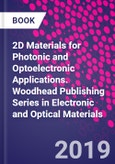2D Materials for Photonic and Optoelectronic Applications introduces readers to two-dimensional materials and their properties (optical, electronic, spin and plasmonic), various methods of synthesis, and possible applications, with a strong focus on novel findings and technological challenges. The two-dimensional materials reviewed include hexagonal boron nitride, silicene, germanene, topological insulators, transition metal dichalcogenides, black phosphorous and other novel materials. This book will be ideal for students and researchers in materials science, photonics, electronics, nanotechnology and condensed matter physics and chemistry, providing background for both junior investigators and timely reviews for seasoned researchers.
Please Note: This is an On Demand product, delivery may take up to 11 working days after payment has been received.
Table of Contents
1. Introduction2. Optical modulators based on 2D materials3. 2D Materials for laser applications4. Infrared photodetectors5. Two-dimensional materials toward future photovoltaic devices6. Black phosphorus: Light-matter interactions and potential applications7. Light-emitting devices8. Flexible and stretchable inorganic electronics: Conductive materials, fabrication strategy, and applicable devices9. 2D materials for bio-photonic applications10. Valleytronics in 2D semiconductors11. Perspective







